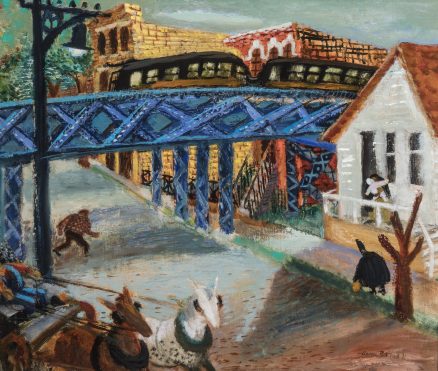- Categories
- Chicago places & people
- Zoom in on Artwork
- Print Page
- Email Page to Friend
Fanciful tints enliven a prosaic scene from Aaron Bohrod’s own neighborhood in his painting Orleans Street, Chicago. As a lighted “L” (elevated) train passes over a vivid blue metal bridge, daily life proceeds below: a horse-drawn cart or wagon dashes by at the lower left; a man runs across the street under the tracks; a bent figure in black walks by a white frame cottage, where a woman holds a child on the narrow front stoop. The antiquated buildings are remnants of the booming development Chicago experienced after the devastating Great Fire of 1871. By the early twentieth century, the North Side area known as Old Town (now almost wholly gentrified) was a down-at-the-heels quarter whose low rents attracted many artists. The neighborhood was within easy reach of downtown via the L. The painting probably shows the point where the track of the Ravenswood (now Brown) Line crosses Orleans Street just south of North Avenue as it curves westward toward the Sedgewick station.
In 1932, Bohrod returned to his native Chicago from two years of study in New York and quickly launched his career with a well-received solo gallery exhibition of prints and watercolor paintings. Of these works the Tribune’s art critic, Eleanor Jewett, wrote admiringly, “Mr. Bohrod dashes through Chicago and New York and laughingly, whimsically shows us the park, the streets, the elevated, a hit-and-miss medley of scenes and places of which each is a gem in the beauty of its coloring.”i For the next few years Bohrod continued to paint the city around him in this light-hearted vein, creating Orleans Street, Chicago and other oil paintings of neighborhood places, often showing the L. In picturing everyday life around him, he was inspired by the teaching and example of John Sloan, his most important instructor at New York’s Art Students League; he was also following a current national trend in favor of accessible, relatable American themes. The naïve style, expressive brushwork, and buoyant colorism of this and other early paintings by Bohrod seem to defy the grave mood of a nation gripped by the Great Depression. Soon, however, the artist developed a harder, more detailed, and somber-toned approach to painting the decayed urban scene, one more in keeping with the times.
Wendy Greenhouse, PhD
i Eleanor Jewett, “Two Good Art Exhibits Vary in Treatment,” Chicago Tribune, Oct. 5, 1932.
